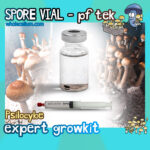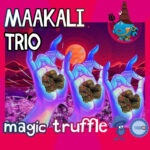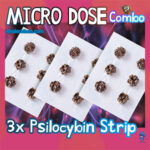Psychedelic trips and near-death experiences; despite their obvious differences, they are often both cited as life-changing events — altering perspectives, changing priorities, awakening spirituality. But how can we truly compare and contrast these experiences? Find people who’ve had both, and ask them, that’s how!
Yep, researchers for the study, published August 30th in Neuroscience of Consciousness, went on a mission to find people who have had both profound psychedelic trips and near death experiences. Not the easiest job — though maybe not quite as rare as we initially thought… Did you know that apparently 5-10% of the general population have had near-death experiences (NDEs)?
What is a Near-Death Experience?
As you’re probably aware, in many near-death experiences a person will be briefly, clinically, dead. For example, after a cardiac arrest the brain and body may shut down for a brief period before resuscitation. In a significant number of cardiac arrests (approximately 20% according to some studies) individuals report having a striking series of experiences, despite their brains showing no signs of activity.
Often, people report leaving their body, and looking down on the scene from above. Sometimes they can even describe medical procedures that were done to them in detail. They might see a compilation of their whole lives flashing by in just a few seconds.

Despite the fact that NDEs only last a maximum of a few minutes, they almost always seem to have a transformational effect. People often undergo a major shift in values and perspective. They can feel more connected to nature, with more love and compassion for other people. They care less about material items, and become more altruistic.
While some have tried to rationalize NDEs as a hallucination caused by unusual brain activity, these strong changes experienced by individuals suggest there is more to it than this.
Comparing Trips and NDEs
On the surface, psychedelic trips and near death experiences may not seem to have so much in common. Frequently, those who experience a NDE describe traveling through darkness to a light at the end of a tunnel, reaching a border or end point, seeing their life in review, or encountering a deceased relative. These are not necessarily features of a psychedelic trip.
How is it then, that they can have such similar effects?

How the Study Worked
This is what the study aimed to find out. The researchers collected first-hand accounts from 31 adults (mainly men from the UK and US) who had tried psychedelics such as psilocybin mushrooms, LSD, ayahuasca, DMT, or mescaline and had near death experiences. They asked them to compare and contrast these events. The results revealed fascinating similarities as well as notable differences. Significantly, psychedelics seemed to engage the visual system more intensely, while NDEs more intensely disrupted bodily sensations.
Participants for the study were recruited via social media, local news, and academic publications. The researchers asked them questions through online surveys, such as;

“At the time of the experience, did you consider that this experience was ‘real’ (ie. different from a dream or hallucination)?”
or
“According to you, was this experience supernatural?”
Many of the participants were experienced trippers (21% of them had tried psychedelics more than 100 times), and the most frequently used substances were magic mushrooms and LSD.
The Similarities and Differences Between Psychedelic Trips and NDEs
The main similarities between psychedelic trips and NDEs were:
- Feelings of harmony/unity
- Distortions in time perception
- The sensation of leaving the earthly world (i.e.going to another place or reality)
The main differences between psychedelic trips and NDEs were:
- Differences in bodily effects — e.g. stronger visuals on psychedelics, and more disembodiment in NDE
- Participants reported being more open and friendly after a psychedelic trip, whereas NDEs were more likely to have had a negative effect on people’s lives.
“One can hypothesize that NDE is more often associated with an impression of ‘suprareal’ due to its unexpected and involuntary occurrence, as compared with a PE [psychedelic experience] which is (typically) intended,” the authors wrote.
‘Suprareal’ is when something exists beyond our comprehension — surreal, beyond our visible realities.
When we take shrooms, for example, the majority of the time this is on purpose. We aim to have a psychedelic experience; whereas a NDE is usually unexpected, an accident, or an unwanted health event. This changes the way we go into these experiences, perhaps explaining why an NDE is more incomprehensible and shocking to our reality.

Christopher Timmermann, a research fellow at the Center for Psychedelic Research at Imperial College London and an article author, told the Times;
“In recent times, the science of consciousness has become interested in nonordinary states… To get a comprehensive account of what it means to be a human being requires incorporating these experiences.”
Study Limitations:
The study did have some limitations. The researchers noted that self-reported responses to online surveys tend to be less reliable as the questions given can lead to bias. Additionally, none of the participants had used 5-MeO-DMT, which is relevant because previous studies had shown that DMT experiences share striking similarities to NDEs. However, study leader Charlotte Martial pointed to another study she had led, which compared NDEs and psychedelics using natural language processing tools. The study, published in Consciousness and Cognition journal found that it was actually ketamine that produced the most similar phenomenology to NDEs. This suggests that atypical psychedelics such as ketamine and salvia might be worth studying further too.

A Reminder of the Preciousness of Life
Both psychedelic trips and NDEs take us beyond the normal limitations of consciousness and familiar awareness. Our regular, non-altered state sees the world through a filter of our own thoughts, expectations, and associations. During an NDE, or a psychedelic trip, the world can become a different place. We may feel a sense of unity and harmony that was hidden just behind the veil of our consciousness, which can be revelatory. Both psychedelic trips and NDEs can remind us of the preciousness of life, and encourage us to move forward with this appreciation in mind.





